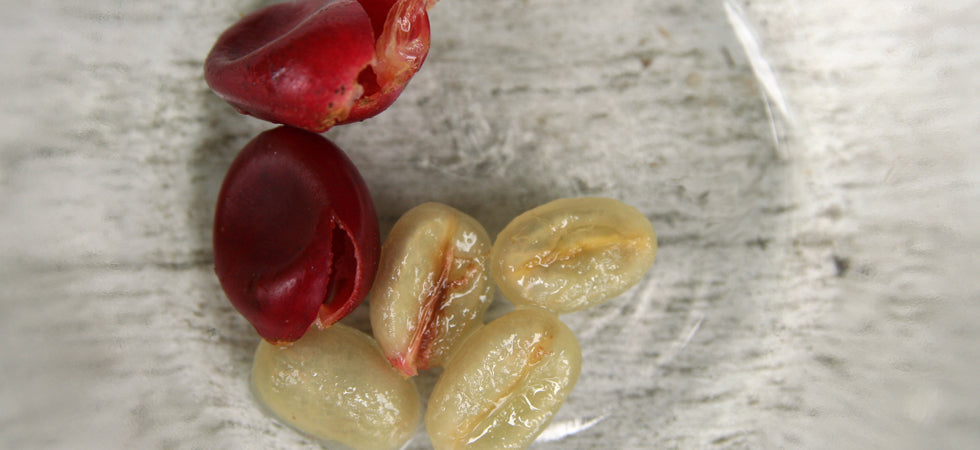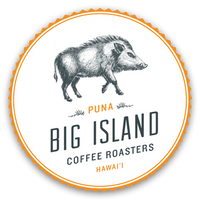
Note: this blog first appeared for members of our Hawaiian Coffee of the Month Club and was intended to explain the differences between a rich black honey processed coffee they received, Ka'u Lehua Black Honey, compared with a sweet and fragrant yellow honey processed coffee they also received called Ka'u Morning Glory.
Coffee processing is one of the most complex and misunderstood parts of creating coffee. But it's also one of the most exciting! Through various farm-level processing techniques, we create the flavor you taste in your cup. And while there aren't as many manufactures of, say, exciting new coffee pulpers as there are trending new coffee brewers, there's a lot we can do with the limited equipment options we have.
For instance, by adjusting the amount of sweet pulp scraped off of a fresh coffee cherry, we can fine tune your espresso experience. Heavier amounts of pulp become red and black honey processed coffees, and those are notorious for making exceptional espressos because they have a syrupy, full-bodied mouthfeel, dried fruit flavors, and lower perceived acidity.
Alternatively, when the pulp is entirely removed, it's been 'demuciliaged' and will taste similar to a washed coffee. But the difference between a demucilaged coffee and a washed coffee is that demucilaged coffees does not require fermentation, and so they tend to be less complex in flavor and more straightforward and crisp.
In between, we have yellow honey processed coffees. These are delightful for espresso or pour over, when you want rich yet mellow coffee that's never bitter or acidy. In fact, the flavors are often similar to real honey: floral, sweet, buttery and smooth with an ever-so-slight hint of fruit and blossoms. Often you'll catch the aroma of vanilla, nougat or honey, regardless of the roast level.
Our favorite year-round honey processed coffee is Ka'u Morning Glory for light to medium roast drinkers, and Ka'u Darkwood for dark roast lovers.
To understand the flavors and spectrum of honey processed coffee, it's helpful to look at the history and techniques used in making honey processed coffees.
What is a honey processed coffee?
No, it’s not adding honey to the coffee nor is it a cup of coffee made by a romantic admirer. Like “natural” or “washed,” “honey process” is a coffee processing method – the important step of separating the outer layers of the coffee cherries from the seed or bean. Once the coffee cherry skin is removed, a mucilage/pulp is exposed.
This mucilage has a sticky texture, sweet flavor, and a golden amber color reminiscent of honey. Producers in Central America called the mucilage (“honey” in Spanish), and so, the method was dubbed the honey process.

HISTORY: IT BEGAN "NATURALLY"
Before equipment and technology, coffee cherries were simply harvested then laid out to dry in the sun. The dried layers of fruit would then be removed until only the coffee bean remained. This process is known as the “dry process” or “natural process” and is very common with commodity-grade coffee growers because it doesn't require much water, equipment or sophistication. In fact, robusta and dried natural coffees are the most common commodity-grade coffees produced world-wide (particularly in Brazil and Vietnam).
 Specialty grade natural coffee cherries are “dried in the fruit”. Notice they are uniformly red. This picture is of our Puna Natural coffee.
Specialty grade natural coffee cherries are “dried in the fruit”. Notice they are uniformly red. This picture is of our Puna Natural coffee.
Natural process coffees are less common with specialty (premium) coffee growers because it’s the most labor intensive and risky processing method. It requires attentive, careful drying of the cherries. If the cherries are neglected or rained on during a sudden storm, they can dry improperly, foul, and even rot. Of course, this would result in a low-quality cup and specialty importers that may reject the coffee.
To overcome these drying challenges, producers started removing the coffee’s outer layers with depulper equipment and water before drying. This greatly reduced the risk of the coffee fouling and allowed producers to command a higher price. But this process, known as the “washed process” or “wet process,” requires a lot of water. Water used to remove the fruit layers can account for over half of the water used in the washed process. The remaining water gets used in tanks for fermentation and washing away any residual flesh, leaving the beans squeaky clean before drying. This practice is more common in areas without frequent water shortages - like Hawaii and Central America.
PULPED NATURAL & HONEY PROCESS COFFEE IS BORN

Customer favorite Honeyed Yellow Caturra being mechanically pulped then raked on drying racks. Several weeks later, the mucilage has dried thick onto the parchment layer of the seeds.
Unfortunately, water access is still an incredible challenge in many parts of the world. In the 1970s, Pinhalense, a Brazilian coffee equipment manufacturer, sought out a more water-efficient way to process coffee. They conducted processing experiments with the goal of producing coffee with high cup quality and less water usage. As a result, the pulped natural process was born. The process is similar to the washed process in that all outer layers are first removed by a depulper and water, but it then skips the fermentation and washing steps, and goes straight out to dry.
In 2008, an earthquake left Costa Rica in extreme water shortages. Coffee producers didn’t know how they were going to wet process their coffees, but after looking at other water-saving methods, they got creative and came up with the honey process.
The process is similar to the pulped natural process in Brazil: outer layers of the coffee are still depulped mechanically, but the machines can control how much flesh is removed. With this process, producers can decide how much of the coffee’s mucilage layer is left on.

THE DIFFERENT SHADES OF HONEY
Since producers varied how much mucilage they removed, terminology developed around describing honey processed coffees by their drying color — white, yellow, red, and black. Coffees with more mucilage removed in the depulping phase tend to dry faster and be lighter in color. Coffees with less mucilage removed tend to dry slower and be darker in color.
BLACK, RED & YELLOW HONEY PROCESS COFFEE
Black honeyed coffees are the most labor intensive of the honey processed coffees because like natural processed coffees, most of the mucilage is still intact. Drying times can double between white and black honeyed coffees. This long drying time can lead to the potential of over-fermentation or fouling if beans are not cared for and dried at the right pace.
The trade off is that this method can bring out an amazing complexity and a depth of flavors. Black and red honeyed coffees tend to be full-bodied, sweet with fruit-forward undertones and a balanced acidity.
Yellow honey processed coffees are delightful and have flavors you might attribute to real honey: floral, sweet, and smooth with an ever-so-slight hint of fruit. Often you'll catch the aroma of vanilla or honey, regardless of the roast level.
Our favorite, year-round honey processed coffee is Ka'u Morning Glory for light to medium roast drinkers, and Ka'u Darkwood for dark roast lovers.
Overall, honey process coffees showcase the possibilities of what can be achieved combining the best flavor attributes from a washed coffee and a natural coffee into one.
The next time you come across a honey processed coffee, also try its counterparts: natural and honey process.Know that every method chosen is for specific reasons, but with one goal in mind: to bring you the most beautiful expression of natural flavors, from the farm to your cup.




